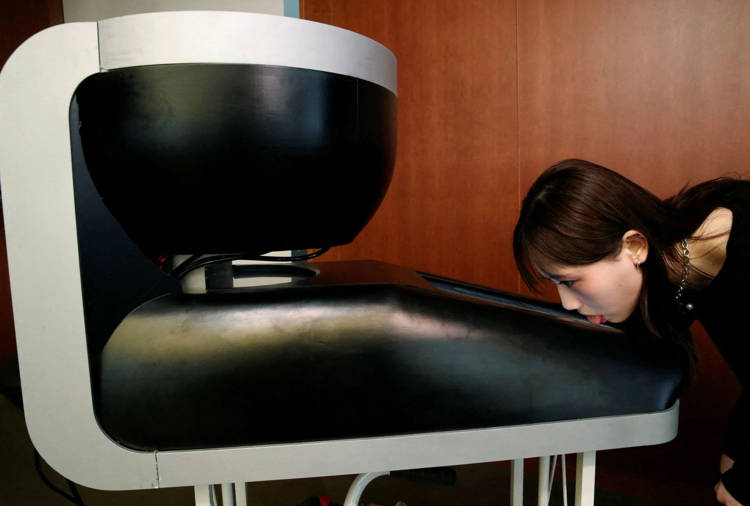Japanese Convenience Stores Introduce AI-Powered Shelf-Stocking Robots

Family Mart, Japan’s second-largest convenience store chain, recently started using AI-powered robots to restock shelves, as a way to deal with the country’s fast-shrinking workforce. The decline in labor population is one of the biggest threats to businesses operating in Japan, and some have already started looking for ways to replace human workers. Case in […]
Real-Life Minority Report – Algorithm Predicts Crime With Up to 90% Accuracy

Scientists at the University of Chicago have developed a new algorithm that forecasts crime with up to 90% accuracy by analyzing data and learning patterns. Minority Report is a very popular sci-fi film about a special police unit that can arrest murderers before they commit their crimes with the help of three clairvoyant humans called […]
Engineer Creates Functional Half-Wheel Bicycle

You may think that wheels are essential when it comes to bicycles, but one resourceful engineer’s recent invention demonstrates that two half wheels are just as good as one full wheel. Sergii Gordieiev, engineer and YouTuber extraordinaire, is known for his ingenious inventions – including a chainless bike and a drill-powered ice bike – but […]
AI-Powered Tanker Becomes First Ship to Cross the Atlantic Ocean Semi-Autonomously

Prism Courage, a 134,000-tonne commercial tanker, recently sailed from the Gulf of Mexico to South Korea while controlled mostly by an artificial intelligence system called HiNAS 2.0. Avikus, a subsidiary of South Korean technology giant Hyundai, recently announced that Prism Courage, a tanker designed to transport natural gas, had become the first large ship to […]
Speech2Face – An AI That Can Guess What Someone Looks Like Just by Their Voice

Speech2Face is an advanced neural network developed by MIT scientists and trained to recognize certain facial features and reconstruct people’s faces just by listening to the sound of their voices. You’ve probably already heard about AI-powered cameras that can recognize people just by analyzing their facial features, but what if there was a way for […]
Smart Chopsticks Use Electrical Stimulation to Enhance Food Flavors

Japanese beverage maker Kirin Holdings teamed up with researchers at Meiji University in Tokyo to create smart chopsticks that reportedly make food taste more savory. Meiji University professor Homei Miyashita has been researching electrical stimulation as a way to alter the way people experience food and flavor for years. In 2016, along with fellow researcher […]
This Device Lets You Feel Virtual Reality Pain in Real Life

A Japanese startup is trying to blur the line between reality and virtual reality with technology that allows the wearer to feel the pain experienced inside the metaverse in real life. H2L Technologies, a Sony-backed technology company based in Tokyo, recently unveiled a wristband that dishes out small electric shocks whenever the wearer suffers pain-inducing […]
Farmer Makes His Cows Wear VR Goggles to Increase Milk Production

In an attempt to increase the daily milk yield of his cows, a farmer in Turkey is experimenting with virtual reality goggles that make the bovines think they are in the middle of a green pasture in summer. İzzet Koçak’s family has been rearing cattle on a farm in Aksaray, Turkey for three generations, and […]
Netlicks – Professor Creates “Lickable” TV Screen That Imitates Taste of Food

A Japanese professor has created a prototype lickable TV screen that can reportedly imitate the taste of various foods. Dubbed Taste the TV (TTTV), the prototype was developed by Homei Miyashita, a professor at the prestigious Meiji University in Japan, as a step towards a true multisensory viewing experience. The Intriguing device uses a carousel […]
Man Singlehandedly Builds Eerily Realistic Robot Arm Powered by Synthetic Muscles

A Polish robotics engineer recently posted a series of intriguing videos of what looks like a dextrous android arm powered by synthetic muscles. Łukasz Koźlik, who goes under the moniker Automaton Robotics online, is a talented robotics engineer from Poland who has spent the last few years creating an incredible synthetic muscle arm that moves […]
Scientists Use Brain Implant to Cure Woman’s Severe Depression

A woman who had exhausted all other options of treating her depression claims her life has become infinitely better since having a matchbox-sized implanted into her skull. Having holes drilled into your skull and electrical wires connected directly to your brain sounds like a daunting proposition for most people, but for Sarah, a 36-year-old woman […]
Microchip Manicure Turns Your Nails into Digital Business Cards

A beauty salon in Dubai has been getting a lot of attention for its microchip manicure, which involves applying a small NFC chip onto the client’s fingernails and turning them into business cards. We covered the trend of having NFC microchips inserted under the skin to make interacting with gadgets a more seamless experience, but […]
Chinese Army Showcases Eerily Realistic Fish-Like Underwater Drone

An ultra-realistic underwater drone modelled after the arowana fish has been getting a lot of attention online, after making its debut at a military expo earlier this month. This year’s Beijing Military Expo opened on June 5th, but it wasn’t the tanks, missiles, and other potentially lethal military equipment that drew reporters’ attention, it was […]
Engineer Falls Off Bicycle, Creates Self-Balancing Bike That Anyone Can Ride

After losing his balance and falling off his bicycle, a bright Chinese engineer dedicated his spare time to designing and building a bike that not only self-balances, but also detects and avoids obstacles. I never learned how to ride a bicycle, and I always wondered how people managed to keep their balance on those two […]
Meet China’s First AI-Powered Virtual University Student

Hua Zhibing officially registered and became a student of Beijing’s Tsinghua University on Tuesday. But she’s not just another student, but China’s first AI-powered, virtual student. Hua Zhibing’s appearance, voice and even the music playing in the background of the vlog she introduced herself to the world in were all created using on a record-breaking […]
